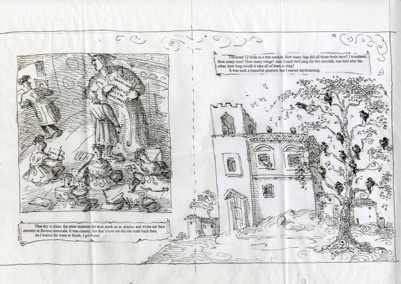Part of the fun of our children’s book is looking for all the Fibonacci objects—bunny rabbits, pinecones, sunflowers, spirals—hidden in the artwork. Leave it to two guys from New Jersey to bring this Medieval master to life! I thought I would share the interview I had with illustrator John O'Brien back in 2010 about his sketches.
John: This is the first spread in the book. Fibonacci sits on a hill looking out over a Tuscan landscape. It's a simple scene, but it's a good example of embedding a spiral into the art before kids actually know that Fibonacci's numbers can form spirals. At the beginning, they probably aren't going to notice it. But later, when they go back through the book, they will!
Joe: You have to look closely, but it's a tiny ram or goat that's gotten loose and two farmers are chasing it across a field. The ram's tracks form a spiral. And of course, the ram has spiral-shaped horns...
John: Spirals are hidden everywhere in this book. Sometimes they're obvious, sometimes not. If you look at the tree in this spread, you can actually see the light pencil outline of a spiral. And then I arranged the birds according to that spiral.
Joe: In the finished book, you only see the birds, not what's organizing them.
John: Well sure! Sometimes, I only do things to things for myself, to have a little fun with it!
Joe: Okay, let me set this one up. This is the medieval center center of Pisa, where Fibonacci lived as a boy. He's just run away from school, and he runs out into the streets. If you look closely, you can see him in bottom right.
John: In any book, sooner or later, you have to pull back and show people the setting, give them a sense of the environment where the characters live. And if you look closely, you'll see that the buildings are arranged in a spiral shape, too.
Joe: I must have looked at this a million times and never noticed that! Okay, later Fibonacci sets sail with his father for Northern Africa. I love that you hid numbers in the water beneath the ship.
John: That was a good way to fit in the Hindu-Arabic numerals that he learns about when he's in Algeria. And you'll see that the architecture is different now. Minarets and domes. And in the marketplace I tried to put things people would have sold there. The city was famous for candles, so one of the vendors is selling candles.
Joe: We're going to jump ahead to later in the book when Fibonacci draws a series of squares in the sand. This is the first time we explicitly show how the number pattern forms a spiral.
John: I basically did two scenes, a close-up on the left, and another from higher up when he draws the spiral. Once a kid sees that spiral, they can probably go back through the book and find all of the others hidden in the book. By the way: that's a starfish on the left. It has five arms, which is a Fibonacci number!
John O’Brien
Joe: So now we come to the rabbits. A lot of people have tried to show this progression from one pair to zillions of pairs, but no one has ever drawn it this way.
John: [Laughs.] Yes, I thought it would be fun to put the rabbits inside what is basically a cut-out of a nautilus shell, which is a spiral. On the left is the first month, only 1 pair of rabbits. Then in the second month, 2 pairs. And so on.
Joe: You really only show seven months, though, John.
John: Well, sure! Otherwise I'd have to make the rabbits smaller. After a while, it's just too many rabbits!
Yes, I am trying to post here more often. Thank you for noticing. If you want to sign up for my newsletter and claim your collection of free ebooks, go here. Thanks!





















